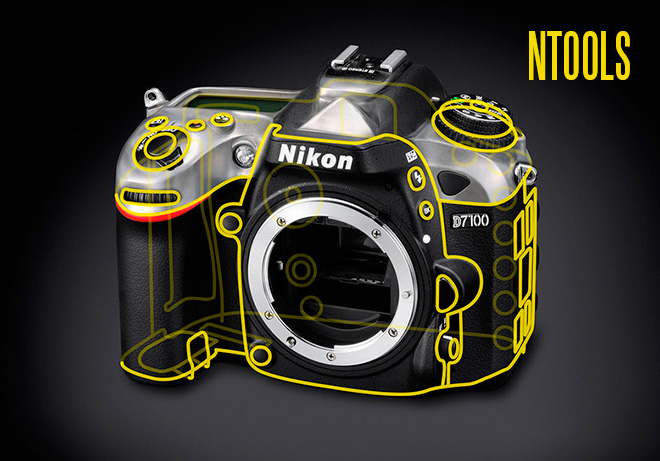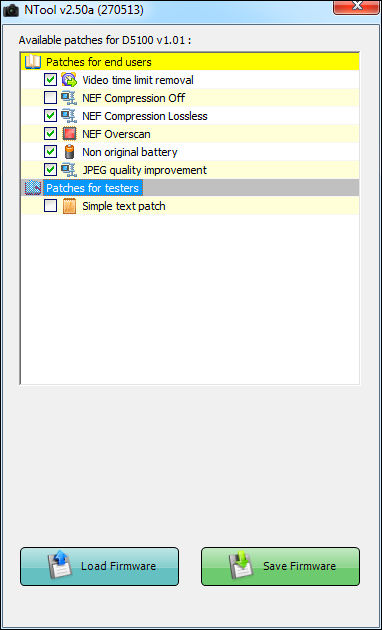
Our favourite GH2 hacker Vitaliy Kiselev has just released version 2.55 of NTools, his firmware patcher for Nikon cameras. Vitaliy says there’s references to ‘LiveView Raw’ in the firmware. What does it refer too?
This is actually the first time I have noticed NTools as opposed to PTools for Panasonic cameras but Vitaliy’s project has been slowly bubbling under the surface for a long time now and allows basic patches such as the removal of the 29 minute video time limit and the ability to turn off NEF raw compression.
Says Kiselev –
D7100 has fun string present in firmware “A:LvRaw%03d.raw”. If someone do not understand, it means LiveView Raw.
Of course we can have our suspicions. I certainly have mine but as of yet we don’t yet know what Vitaliy will be able to on these cameras. It seems like a reference to a file called LvRaw.raw but Vitaliy doesn’t at this time divulge any more information – he’s still in the process of finding out about the firmware himself.
NTools supports a very wide range of Nikon DSLRs including the very promising V1 which can do a full 4K resolution sensor output at 60fps.
The Nikon D5200 is not yet supported as there’s no official firmware update available for it. If I were Nikon I’d be hammering down Vitaliy’s door to give him assistance in creating firmware patches for raw video. Nikon are using much faster processors than Canon in their DSLRs from top to bottom and in some cases like on the D7100 a much faster SD card interface, and two slots. Even the mirrorless Nikon V1 has a similar processor to the flagship Nikon D4. Unlike Canon who use a lot of off the shelf chips on their mainboards to perform dedicated tasks such as H.264 encoding, Nikon’s approach is more centred around a more powerful general purpose CPU – perfect for running custom code and a hack.
Here’s a full list of supported cameras in NTools –
Since v2.50
- Added support and patches for D7000 v1.04.
- Added support and patches for D3200 v1.01.
- Added patches for D3100 v1.01.
- Added patches for D5100 v1.01.
- Added support for D600 v1.01 (only text patch).
- Added support for D800 v1.02 (only text patch).
- Added support for D800E v1.02 (only text patch).
- Added support for Nikon J1 v1.20 (only text patch).
- Added support for Nikob V1 v1.21 (only text patch).
Since v2.55
- Added battery patch for D3200 v1.01.
- Added support for Nikon J1 v1.30 (only text patch).
- Added support for Nikon J2 v1.10 (only text patch).
- Added support for Nikon J3 v1.10 (only text patch).
- Added support for Nikon V1 v1.30 (only text patch).
- Added support for Nikon V2 v1.10 (only text patch).
- Added support for Nikon S1 v1.10 (only text patch).
Here’s an example of the available patches in NTool for the Nikon D5100. The Windows application has the same user interface as PTools for the GH2.

Vitaliy’s hack works in a different way to Magic Lantern. It’s debatable whether Vitaliy will have enough access to the camera to enable raw video recording, but if there’s already code running on the camera that just needs to be switched on, it could well be possible.
In my view, all manufacturers need to get serious about the new image quality challenge presented to them by Magic Lantern.
The 5D Mark III gives me very little reason to use another DSLR for video, such is the leap up in image quality.
There’s a huge opportunity for Nikon and Panasonic here – the opportunity to solve the headache many have with very large raw files. 10bit LOG ProRes would be a suitable alternative to raw, giving us a similar level of image quality but with smaller more manageable files. These files would be far less demanding on your computer to edit or transcode. You’d lose some flexibility in post with the grade but 10bit ProRes still remains very attractive to me on work that requires a fast turnaround.
I very much liked the Nikon D5200, which had a very similar image to the 5D Mark III in video mode prior to the raw revolution. Now it is simply outclassed and Nikon need to catch up.
The sensor in the D5200 and D7100 would likely be a superb candidate for a direct tap on raw video. The Toshiba sensor delivers a very clean moire-free raw video image to the buffers unlike the Nikon D800 which employs line skipping on the monster 36MP full frame sensor.


